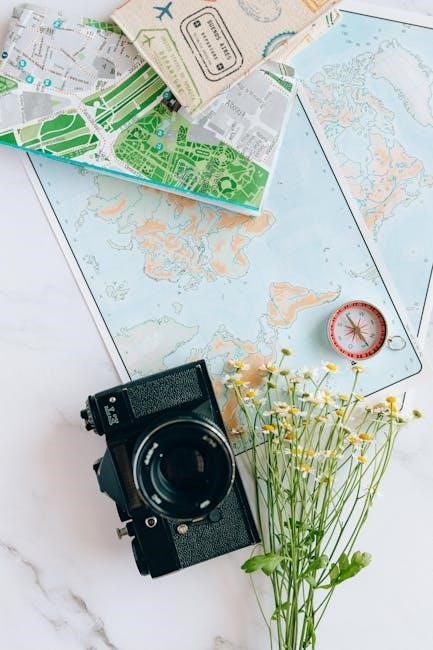Lash mapping is a planning technique for eyelash extensions, creating a visual guide for lengths, curls, and thicknesses to enhance natural lashes and achieve desired looks․
1․1 What is Lash Mapping?
Lash mapping is a strategic technique used by lash artists to plan and design eyelash extension applications․ It involves creating a visual guide that outlines the lengths, curls, and thicknesses of extensions to be applied in specific zones of the eyelid․ This process ensures a customized look tailored to the client’s eye shape, natural lash line, and desired aesthetic․ By mapping out the placement of lashes, artists can achieve a seamless, natural, or dramatic effect, enhancing the client’s features while maintaining comfort and longevity․ Lash mapping is a fundamental step in delivering personalized and professional eyelash extension results․
1․2 Importance of Lash Mapping in Eyelash Extensions
Lash mapping is essential for creating customized eyelash extension looks that enhance natural beauty․ It ensures extensions are placed strategically to complement eye shape, lash line, and personal style․ Proper mapping prevents overcrowding or sparse areas, promoting a balanced and polished appearance․ It also enhances longevity by distributing lash extensions evenly, reducing strain on natural lashes․ By tailoring lengths, curls, and thicknesses to specific zones, lash mapping achieves desired effects like opening the eyes or creating a dramatic look․ This technique elevates the quality of lash applications, making it a cornerstone of professional eyelash extension services․ It ensures client satisfaction by delivering results that align with their aesthetic preferences․

Step-by-Step Lash Mapping Guide
Start with consultation, assess eye shape, determine lash thickness and curl, select lengths for zones, and create a detailed map for precise application and stunning results․
2․1 Consultation and Client Assessment
Consultation is the foundation of lash mapping, ensuring a personalized approach․ Begin by discussing the client’s preferences, lifestyle, and desired outcome․ Assess their eye shape, natural lash line, and personal style to determine the most flattering look․ Measure lash length and curl to tailor the extensions․ Consider the client’s daily routine to choose low-maintenance or high-drama options․ This step ensures the lash map aligns with their features and expectations, creating a bespoke design that enhances their natural beauty while meeting their lifestyle needs․ A thorough assessment guarantees a seamless and stunning result․
2․2 Analyzing Eye Shape and Natural Lash Line
Analyzing eye shape and the natural lash line is crucial for creating a personalized lash map․ Begin by identifying the client’s eye shape—almond, round, hooded, or deep-set—as this determines lash placement․ Measure the natural lash line to understand its length and density․ Note where the lashes are sparse or full, as this impacts extension distribution․ For example, shorter lashes are often placed at the inner corner, while longer ones enhance the outer edge․ This step ensures the extensions complement the client’s natural features, creating a balanced and flattering look tailored to their unique eye structure and lash line characteristics․
2․3 Determining Lash Thickness and Curl
Determining lash thickness and curl is a critical step in lash mapping, ensuring extensions complement the client’s natural lashes․ Assess the natural lash thickness to choose extensions that blend seamlessly․ For finer lashes, lighter weights are ideal, while thicker lashes can support bolder options․ Curl selection is based on eye shape and desired drama—soft curls for subtle looks, and tighter curls for more definition․ Tools like calipers and curl gauges help measure and match precisely․ Proper curl and thickness choices enhance the lash line’s natural appearance, ensuring a balanced and polished result․ Mixing curls strategically can add depth and dimension for a more dynamic effect․
2․4 Selecting Lash Length for Different Zones
Selecting lash lengths for different zones is vital for achieving a balanced and personalized look․ The eye is typically divided into three zones: inner corner, middle, and outer corner․ Shorter lashes are often used in the inner corner to create a natural appearance, while longer lashes in the middle and outer zones can add drama and depth․ The transition between lengths should be gradual to avoid abrupt changes․ Tools like measuring tapes or lash gauges help determine the ideal lengths for each zone․ The client’s eye shape and natural lashes guide this process, ensuring extensions complement their features․ Proper length selection enhances the overall aesthetic, making the eyes appear larger or more defined based on the desired style․
2․5 Creating the Lash Map
Creating the lash map involves translating the assessed measurements into a visual plan․ Using lash mapping templates, artists sketch the zones, marking where each lash length, curl, and thickness will be applied․ This step ensures precision, guiding the application process․ The map is customized based on the client’s eye shape, natural lashes, and desired outcome․ It serves as a blueprint, helping technicians maintain consistency and achieve the intended look․ Accurate mapping is key to a seamless and flattering result, making the lash extensions appear natural while enhancing the client’s features․ This step is crucial for both aesthetics and application efficiency, ensuring each extension is placed correctly for optimal effect․

Common Lash Mapping Styles
Common lash mapping styles include Open Eye, Cat Eye, and Squirrel techniques, each designed to enhance specific eye shapes and achieve unique, flattering looks․
3․1 Open Eye Lash Map
The Open Eye Lash Map focuses on placing the longest lashes in the center of the lash line, creating a wider, more open appearance․ This style is ideal for clients with smaller or hooded eyes, as it enhances the illusion of larger eyes․ By strategically positioning longer lashes in the middle and gradually shorter ones toward the corners, the Open Eye technique ensures a balanced, natural look․ This method is particularly effective for achieving a bright, awake appearance and can be tailored to suit individual preferences or eye shapes, making it a versatile choice for various clients․
3․2 Cat Eye Lash Map
The Cat Eye Lash Map is a popular style designed to create a dramatic, almond-shaped appearance․ This technique involves placing shorter lashes at the inner corner, with lengths gradually increasing toward the center and then tapering off at the outer corner․ The result is a sleek, dynamic look that mimics the shape of a cat’s eye, enhancing the overall eye shape and adding depth․ This style is particularly favored for its ability to create a bold, eye-catching aesthetic while maintaining a natural transition between lash lengths․
By strategically layering lashes with varying lengths and curls, the Cat Eye Lash Map achieves a seamless blend of volume and finesse, making it ideal for clients seeking a striking yet sophisticated look․
3․3 Squirrel Eyelash Mapping
Squirrel Eyelash Mapping is a technique that creates a dramatic, eye-catching look by transitioning from shorter to longer lashes more pronouncedly than the Cat Eye style․ This method involves placing the shortest lashes at the inner corner, with lengths increasing significantly toward the middle and then decreasing again toward the outer corner․ The result is a dynamic, almond-shaped appearance that enhances the natural eye shape while adding volume and depth․
This style is ideal for clients seeking a bold, dramatic effect, as it creates a striking contrast and draws attention to the eyes․ The gradual transition ensures a natural flow, making it suitable for those who want a noticeable yet balanced look․

Tools and Materials Needed
Essential tools include lash mapping templates, measuring tapes, curl gauges, and tweezers․ High-quality lashes, adhesives, and cleaning solutions are also crucial for precise application and long-lasting results․
4․1 Lash Mapping Templates
Lash mapping templates are reusable tools designed to guide artists in planning precise lash extension placements․ They outline zones for varying lengths, curls, and thicknesses, ensuring a balanced and symmetrical look․ Available in multiple styles, these templates cater to different eye shapes and desired aesthetics, such as open eye, cat eye, or squirrel lash maps․ Made from durable materials, they are easy to clean and reuse, offering consistency across applications; By using templates, artists can achieve a personalized yet professional design, enhancing the overall lash extension experience․ These tools are indispensable for creating flawless, customized lash maps that align with client preferences and natural lash lines․
4․2 Measuring Tools for Lash Length and Curl
Measuring tools are essential for determining lash length and curl accurately․ A lash ruler or caliper helps gauge the natural lash length, ensuring extensions blend seamlessly․ Curl gauges assess the client’s natural curl percentage, guiding the selection of matching extensions․ These tools enable artists to maintain consistency and precision, avoiding over- or under-application․ By measuring lash length and curl, artists can create a balanced, natural look tailored to the client’s features․ Proper use of these tools ensures the extensions complement the eye shape and lash line, enhancing the overall aesthetic․ They are indispensable for achieving a flawless, customized lash extension application that meets client expectations and maintains a professional finish․

Tips for Perfect Lash Mapping
Balance natural and dramatic looks by tailoring lash lengths and curls․ Avoid over-application and excess glue for a seamless finish․ Precision ensures long-lasting, comfortable results․
5․1 Balancing Natural and Dramatic Looks
Balancing natural and dramatic looks in lash mapping involves tailoring lash lengths, curls, and thicknesses to complement the client’s eye shape and personal style․ For a natural appearance, shorter lashes with a softer curl are applied, blending seamlessly with natural lashes․ Dramatic looks, however, require longer, thicker lashes with a more pronounced curl, often concentrated in specific zones like the center or outer corners․ A skilled lash artist can mix these elements to create a cohesive design that enhances the client’s features without appearing overwhelming․ This balance ensures the lashes look stunning while maintaining comfort and wearability․
5․2 Avoiding Common Mistakes in Lash Placement
Common mistakes in lash placement can compromise the final look and comfort of eyelash extensions․ One major error is improper measurement of lash lengths, leading to uneven or unrealistic results․ Another mistake is inconsistent curl selection, which can make the lashes appear mismatched․ Additionally, failing to consider the client’s eye shape and natural lash line during mapping can result in an unflattering design․ To avoid these issues, lash artists should take precise measurements, ensure gradual transitions between zones, and maintain consistency in curl and thickness․ Proper training and attention to detail are key to delivering polished, professional results that enhance the client’s natural beauty while avoiding common pitfalls․

Advanced Lash Mapping Techniques
Advanced techniques involve layering lashes for depth, mixing curls for a dynamic effect, and creating intricate designs like cat eyes or volume lashes for a standout look․
6․1 Layering Lashes for Volume and Depth
Layering lashes involves applying multiple extensions on natural lashes to create volume and depth․ This technique enhances the 3D effect by stacking lashes of varying lengths and curls․ Start with a natural lash, then add a medium-length extension, and finish with a longer one for drama․ This method ensures a balanced, seamless look while adding dimension․ Proper layering avoids clumping and maintains comfort․ It’s ideal for achieving volume or cat-eye styles, offering a more dynamic appearance․ When done correctly, layering creates a fuller, more vibrant lash line that complements the client’s eye shape and desired aesthetic․
6․2 Mixing Lash Curls for a Dynamic Effect
Mixing lash curls adds depth and dimension to eyelash extensions․ By combining different curl types, such as natural, medium, and dramatic curls, you can create a dynamic, eye-catching look․ This technique prevents lashes from appearing flat or uniform, enhancing the client’s natural features․ For example, pairing natural curls at the inner corners with more dramatic curls toward the outer edges can create a cat-eye effect․ This approach ensures a seamless transition between curls, making the lashes appear more voluminous and vibrant․ Mixing curls also allows for customization, catering to individual preferences and eye shapes․ The result is a more dynamic, polished finish that elevates the overall lash design․

Maintenance and Aftercare
Proper aftercare ensures lash longevity and maintains natural lash health․ Gently clean lashes with a lash-specific cleanser, avoiding oil-based products․ Refrain from touching or rubbing your eyes, as this can cause damage or infection․ Use makeup products designed for lash extensions and clean lashes regularly to prevent dirt buildup․
7․1 How Lash Mapping Affects Longevity
Proper lash mapping significantly impacts the longevity of eyelash extensions․ A well-designed map ensures balanced distribution of lashes, preventing overloading natural lashes, which can lead to premature shedding․ Improper mapping may cause uneven stress, damaging natural lashes and reducing extension wear․ By strategically placing lashes according to the client’s eye shape and natural lash line, the extensions adhere better and last longer; Additionally, a good map helps avoid excessive glue or lashes in sensitive areas, minimizing irritation․ Regular aftercare, combined with precise mapping, enhances durability and maintains a flawless look․ Poor mapping can lead to early extension loss, while correct techniques ensure a longer-lasting, natural appearance․
7․2 Aftercare Tips for Clients
To maintain lash extensions, clients should gently clean their lashes daily with a foam cleanser to remove dirt and oils․ Avoid using oil-based products near the eyes, as they weaken the adhesive․ Refrain from rubbing eyes or lashes, which can cause premature shedding․ Using a lash brush to detangle extensions daily helps maintain their appearance․ Clients should also avoid swimming or exposure to excessive moisture for 24 hours after application․ Proper aftercare ensures the longevity and natural look of the extensions․ Regular touch-ups and following these tips help keep lashes looking their best․ Consistent care routine prevents damage and extends the wear of the lashes, ensuring client satisfaction․
Lash mapping is essential for creating personalized, stunning lash extensions, enhancing both appearance and longevity; It ensures a tailored look, making it a vital skill for lash artists․
8․1 The Impact of Lash Mapping on Eyelash Extension Results
Lash mapping significantly influences the final outcome of eyelash extensions, ensuring a natural, tailored, and visually appealing result․ Proper mapping enhances lash line symmetry, boosts volume, and creates a seamless blend with natural lashes․ It prevents overcrowding and ensures extensions complement the client’s eye shape and personal style․ Improper mapping can lead to uneven distribution, discomfort, and a less flattering appearance․ By strategically placing lashes based on length, curl, and thickness, lash artists achieve long-lasting, high-quality results that satisfy client expectations and maintain lash health․ Thus, lash mapping is a cornerstone of successful eyelash extension applications, directly impacting both aesthetics and client satisfaction․
